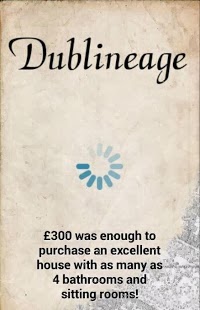Along with all normality, this year's programme of genealogy and history events draws to a halt early next week as we approach the big Christmas shut down. This is your last chance of the year for brain food:
Monday 9 December: Connacht incastellated: pre-Norman and Anglo-Norman castles west of the Shannon, with Professor Tadhg O'Keeffe. Host: Galway Archaeological and Historical Society. Venue: Harbour Hotel, Dock Road,
Galway. 8pm.
Monday 9 December: Reading Yesterday's News, a workshop looking at how the newspaper collections of the State and National Libraries can help your research. Basic computing skills required. 10am to 12noon. AUS$5 incl. GST,
bookings essential. Venue: State Library of New South Wales, Macquarie St,
Sydney, NSW 2000, Australia, Tel: (02) 9273 1414.
Tuesday 10 December: The resources of Ancestry as a support for the genealogist, with Eric Booth. GSI lecture held at Dún Laoghaire College of FE, Cumberland Street,
Dun Laoghaire, Co Dublin. 8pm.
Tuesday 10 December: Silken Thomas and the Siege of Dublin, with Steven Ellis. Milestones of Medieval Dublin lunchtime lectures series.Wood Quay Venue, Civic Offices,
Dublin 8. 1:05pm to 1:45pm. Free. All welcome.
Tuesday 10 December: Volunteers 1913: two traditions or one?, a HistoryIreland Hedge School, with Lar Joye, Michael Laffan, Timothy Bowman and Phiip Orr. Venue:
Belfast City Hall. 6pm. Free, but
booking required. Light refreshments before the event from 5:30pm at Belfast City Hall for those attending Hedge School. A guided tour of City Hall also available at 3:30pm.
Wednesday 11 December: Hidden history of the Belfast Hills, an interactive presentation covering history, wildlife and archaeology. Host: Belfast Hills Landscape Partnership. Venue: Falls Road Library, 49 Falls Road,
Belfast Co Antrim BT12 4PD. Free. 12-1pm. For more information, tel: 028 9050 9212.
Thursday 12 December: Early Medieval Books, with John Dolan. Host: Rathfarnham Historical Society, Church of Ireland Parish Centre,
Rathfarnham Village, Dublin. 8pm. €4 for non-members.
Friday 13 December: The North-West and the Scotch-Irish Diaspora in the 18th and 19th Centuries, with Professor Don MacRaild. Host: Derry City Council Heritage & Museum Service. Venue: Tower Museum, Union Place,
Derry. 6pm. Free. No need to book.
Saturday 14 December: Mayo Genealogy Group Workshop at the National Museum of Ireland, Country Life, Turlough,
Castlebar, Co Mayo. A monthly drop-in event for family history advice and chat. No booking required. Free.
Details.
Wednesday 18 December: Families and Stories from West County Down, with Frank McCorry. North of Ireland FHA, North Armagh Branch. Venue: Town Hall, 15-17 Edward Street,
Portadown, BT62 3LX. 7:30pm–9:30pm.

























